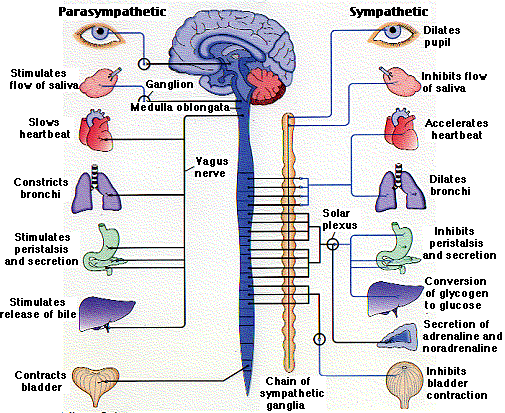Organization of the Nervous System
The nervous system is divided into the
- peripheral nervous system (PNS) and the
- central nervous system (CNS)
The PNS consists of
- sensory neurons running from stimulus receptors that inform the CNS of the stimuli
- motor neurons running from the CNS to the muscles and glands - called effectors - that take action.
The CNS consists of the
- spinal cord and the
- brain
 The peripheral nervous system is subdivided into the
The peripheral nervous system is subdivided into the
- sensory-somatic nervous system and the
- autonomic nervous system
The sensory-somatic system consists of
- 12 pairs of cranial nerves and
- 31 pairs of spinal nerves.
All of the spinal nerves and most of the cranial nerves are "mixed"; that is, they contain both sensory and motor neurons.
All our conscious awareness of the external environment and all our motor activity to cope with it operate through the sensory-somatic division of the PNS.
The autonomic nervous system consists of sensory neurons and motor neurons that run between the central nervous system (especially the hypothalamus and medulla oblongata) and various internal organs such as the:
It is responsible for monitoring conditions in the internal environment and bringing about appropriate changes in them. The contraction of both smooth muscle and cardiac muscle is controlled by motor neurons of the autonomic system.
The actions of the autonomic nervous system are largely involuntary (in contrast to those of the sensory-somatic system).
It also differs from the sensory-somatic system is using two groups of motor neurons to stimulate the effectors instead of one.
- The first, the preganglionic neurons, arise in the CNS and run to a ganglion in the body. Here they synapse with
- postganglionic neurons, which run to the effector organ (cardiac muscle, smooth muscle, or a gland).
The autonomic nervous system has two subdivisions, the
- sympathetic nervous system and the
- parasympathetic nervous system.
The preganglionic motor neurons of the sympathetic system arise in the spinal cord. They pass into sympathetic ganglia which are organized into two chains that run parallel to and on either side of the spinal cord.
 The preganglionic neuron may do one of three things in the sympathetic ganglion:
The preganglionic neuron may do one of three things in the sympathetic ganglion:
- synapse with postganglionic neurons which then reenter the spinal nerve and ultimately pass out to the sweat glands and the walls of blood vessels near the surface of the body.
- pass up or down the sympathetic chain and finally synapse with postganglionic neurons in a higher or lower ganglion
- leave the ganglion by way of a cord leading to special ganglia (e.g. the solar plexus) in the viscera. Here it may synapse with postganglionic sympathetic neurons running to the smooth muscular walls of the viscera. However, some of these preganglionic neurons pass right on through this second ganglion and into the adrenal medulla. Here they synapse with the highly-modified postganglionic cells that make up the secretory portion of the adrenal medulla.
The neurotransmitter of the preganglionic sympathetic neurons is acetylcholine (ACh).
It stimulates action potentials in the postganglionic neurons.
The neurotransmitter released by the postganglionic neurons is noradrenaline (also called norepinephrine).
The action of noradrenaline on a particular gland or muscle is excitatory is some cases, inhibitory in others.
The release of noradrenaline
- stimulates heartbeat
- raises blood pressure
- dilates the pupils
- dilates the trachea and bronchi
- stimulates the conversion of liver glycogen into glucose
- shunts blood away from the skin and viscera to the skeletal muscles, brain, and heart
- inhibits peristalsis in the gastrointestinal (GI) tract
- inhibits contraction of the bladder and rectum
In short, stimulation of the sympathetic branch of the autonomic nervous system prepares the body for emergencies: for "fight or flight".
Activation of the sympathetic system is quite general because
- a single preganglionic neuron usually synapses with many postganglionic neurons;
- the release of adrenaline from the adrenal medulla into the blood ensures that all the cells of the body will be exposed to sympathetic stimulation even if no postganglionic neurons reach them directly.
The main nerves of the parasympathetic system are the tenth cranial nerves, the vagus nerves. They originate in the medulla oblongata. Other preganglionic parasympathetic neurons also extend from the brain as well as from the lower tip of the spinal cord.
Each preganglionic parasympathetic neuron synapses with just a few postganglionic neurons, which are located near - or in - the effector organ, a muscle or gland. Acetylcholine (ACh) is the neurotransmitter of both the pre- and the postganglionic neurons of the parasympathetic system.
Parasympathetic stimulation causes
- slowing down of the heartbeat
- lowering of blood pressure
- constriction of the pupils
- increased blood flow to the skin and viscera
- peristalsis of the GI tract
In short, the parasympathetic system returns the body functions to normal after they have been altered by sympathetic stimulation. In times of danger, the sympathetic system prepares the body for violent activity. The parasympathetic system reverses these changes when the danger is over.
Although the autonomic nervous system is considered to be involuntary, this is not entirely true. A certain amount of conscious control can be exerted over it as has long been demonstrated by practitioners of Yoga and Zen Buddhism. during their periods of meditation, these people are clearly able to alter a number of autonomic functions including heart rate and the rate of oxygen consumption. These changes are not simply a reflection of decreased physical activity because they exceed the amount of change occurring during sleep or hypnosis.
18 April 1999
 The peripheral nervous system is subdivided into the
The peripheral nervous system is subdivided into the
 The preganglionic neuron may do one of three things in the sympathetic ganglion:
The preganglionic neuron may do one of three things in the sympathetic ganglion: